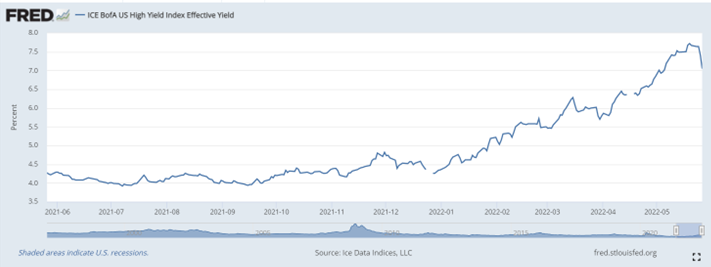The quieter debt market sell-off
While the sell-off in growth stocks and tech stocks has garnered most of the headlines this year, there’s been a quieter sell-off happening in debt markets. Investors who chased the greater yields offered on emerging market debt, high yield bonds and long duration debt have also been burnt this year.
So far the losses have been driven by a repricing of both the base rate (fixed rate debt only) and credit spread components, with defaults remaining very low. But as central banks continue to hike overnight rates and the flood of quantitative easing induced liquidity dries up, defaults are expected to rise across corporate, personal and government borrowers.
The most obvious part of the debt sell-off has been in long-duration debt, as the expectations for more central bank rate hikes flowed through. A standout example is Austria’s century bond which has fallen from $235 in December 2020 to less than $100 this month.
More common examples are the greater than 10% losses on the US and Australian government 10-year bonds in the year to date. These returns would be particularly nasty for risk parity investors, who often leverage up their bond holdings, assuming bonds and equities will exhibit inverse price movements.
Global high yield debt has suffered the double blow of higher base rates and higher credit spreads this year. The graph below from the St Louis Fed’s FRED database of the effective yield on US high yield debt shows a surge in the prospective yield. Defaults remain near all-time lows but that’s forecast to change significantly in the medium term as weaker borrowers are unable to sell new debt or run out of cash. The slump in new issuance and an increasing number of hung and repriced deals show lenders have become far more circumspect this year.

Emerging market debt has suffered from the added factor of a stronger US dollar, as well as higher base rates and higher credit spreads. The war in Ukraine has slammed the debt of Russia, Belarus and Ukraine, with US sanctions expected to cause a default on Russian debt in the coming months. Sri Lanka has just defaulted with Pakistan, Tajikistan and Tunisia seeing a significant spike in their default risk pricing this year. Argentina’s inflation rate is over 50% and another default is expected in the medium-term following on from their 2020 default and debt restructure. China’s developers are dropping like flies with another major developer defaulting this month.
In Australia, it has been comparatively quiet with defaults mainly coming from the construction and property sector as higher costs for supplies and labour have overwhelmed the notoriously thin margins on building contracts.
The step-up in debt collection activities by the ATO should lead to a bump in insolvencies, though these will almost all be small businesses with debts limited to their employees, trade creditors and the ATO.
The risk appetite of the major banks has greatly reduced since the Financial Crisis. Australia’s banks are therefore unlikely to see many large-scale corporate insolvencies like ABC Learning, Allco, Babcock and Brown and Centro that didn’t survive the last downturn.
While there have been noticeably higher spreads on Australian bank and securitisation debt this year, listed bank hybrids have moved comparatively less. These now pay only a small premium over the much lower risk tier-2 debt of the same banks. The comparison with securitisation is starker; the average spread on major bank hybrids is less than some of the A-rated new issues, with some arguably lower risk BB-rated tranches paying double the credit spread. This mispricing is primarily due to retail investors not being aware of the spread changes in adjacent securities that are limited to wholesale investors.
Never miss an insight
If you're not an existing Livewire subscriber you can sign up to get free access to investment ideas and strategies from Australia's leading investors.
And you can follow my profile to stay up to date with other wires as they're published – don't forget to give them a “like”.
4 topics

